2. 生态环境部华南环境科学研究所, 国家环境保护环境污染健康风险评价重点实验室, 广州 510655;
3. 神农架国家公园管理局, 神农架 442400
2. State Environmental Protection Key Laboratory of Environmental Pollution Health Risk Assessment, South China Institute of Environmental Sciences, Ministry of Ecology and Environment, Guangzhou 510655, China;
3. Shennongjia National Park Administration, Shennongjia 442400, China
随着城市化、工业化和人类活动范围的迅速拓展, 重金属污染引起了国内外学者的广泛关注.有研究表明, 重金属污染物排放到环境中, 会造成土壤、水体和生物的污染, 危害生态环境健康[1, 2], 最终对动物和人类健康产生负面影响.主要原因是重金属无法降解, 具有持久性和累积性, 可通过生物富集等作用对动植物造成不利影响[3, 4].但是, 重金属污染对珍稀濒危动物健康风险影响的研究较为少见, 仅对秦岭山脉野生和圈养川金丝猴的重金属暴露进行了评估报道[5].由于珍稀动物特性, 一般不允许直接开展生物样品采集及相应的毒理研究, 极大地增加了研究的难度.目前的野生稀有动物重金属污染研究, 一般使用羽毛、毛发和死体标本等无损伤标本[6], 或通过测定动物器官中污染物的含量对其进行风险评估[7].上述情况极大地加剧了珍稀动物重金属污染研究的局限性, 阻碍了保护工作的开展.栖息地重金属污染是濒危动物健康重要威胁因素之一, 通过栖息地和食源植物重金属污染评价可在不伤害珍稀物种情况下间接反映其受重金属污染情况, 因此开展野生动物栖息地重金属暴露风险评估可以定量重金属的威胁程度, 对于动物的保护和重金属污染的防治具有重要意义.
川金丝猴(Rhinopithecus roxellana)是国家Ⅰ级濒危动物.目前川金丝猴仅分布于四川北部及甘肃南部、陕西秦岭和湖北神农架这3个孤立的地区, 其中湖北神农架是我国川金丝猴种群分布最东端的孤立种群, 种群数量1 400余只, 在金丝猴进化史上占有重要地位[8].关于川金丝猴研究主要有栖息地植物区系特征及栖息地优势树种生态位, 食源植物的可利用性、含水量、各种营养成分含量[9, 10]和生境适宜性评价[11]等方面, 对于川金丝猴栖息地重金属污染水平及其健康风险评价尚未见报道.为了初步评价我国川金丝猴的重金属污染程度, 并评估人类干扰对重金属污染的影响, 本文首次以神农架国家森林公园作为研究地区, 在人类影响程度不同的地区设置取样点, 采集川金丝猴可能暴露的土壤、溪水及其食源植物并测定多种重金属含量, 借鉴评价人类重金属污染健康风险方法, 以确定: ①神农架川金丝猴栖息地重金属污染特征, ②评价川金丝猴栖息地的重金属污染生态风险及其健康风险, ③人类活动是否对栖息地重金属有影响.上述研究将为我国、特别是神农架地区川金丝猴栖息地的生态环境保护提供部分科学依据, 并为经食物途径评价我国珍稀动物重金属健康风险提供方法借鉴.
1 材料与方法 1.1 研究区概况研究区位于中国湖北省神农架林区(109°56′~110°58′E, 31°15′~31°57′N).林区地处东亚东、西两大植物区系的交汇处, 拥有3 700余种植物, 动物种类达1 000余种, 森林覆盖率达90%左右, 具有独特的生态价值和生物多样性[12], 该区域现有川金丝猴共8群, 约1 400余只, 主要分布于金猴岭、大龙潭和千家坪等地区, 栖息于神农架林区海拔1 700~3 000 m之间的针阔混交林中[13].
1.2 研究方法 1.2.1 样品采集与预处理根据川金丝猴活动情况(见表 1), 于酒壶坪(JHP)、神农架国际滑雪场(HXC)、大龙潭(DLT)、小千家坪(XQJP)和金猴岭(JHL)采集样品(见图 1).每一个采样区域选择3~5个间距50~200 m的地点, 选择食源植物3~5株, 采集食源植物的叶、果、树皮或地衣[18], 并将同采样区同种植物混合成一个样品, 室内风干后保存于-80℃冰箱中; 每采样处采集3~5个0~20 cm深度的土壤样品, 并将土壤混合成一个样[19]; 同时, 对附近的水源采集2~3个水样, 带回实验室酸化, 于-18℃下保存备用[20].
|
|
表 1 采样点信息 Table 1 Information on sampling sites |
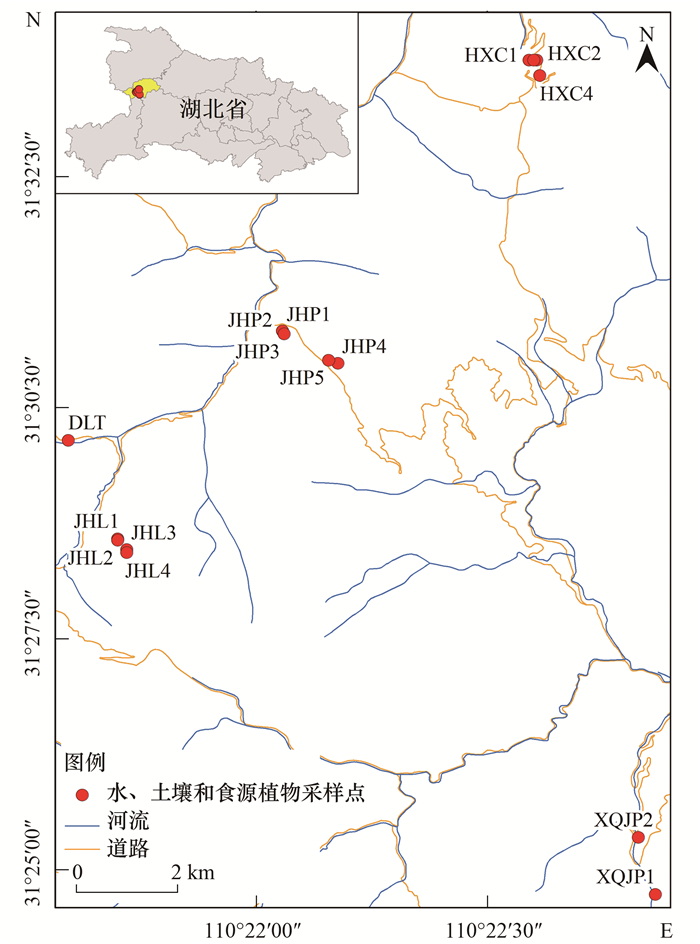
|
图 1 采样点分布示意 Fig. 1 Distribution of sampling sites |
参考Zhao[21]的方法, 称取(0.1±0.02)g植物和土壤样品置于消解罐中, 加入6 mL王水, 采用微波消解仪(MARS, CEM, USA)以梯度式升温程序进行消解, 程序升温条件为5 min升至120℃, 120℃保持3 min, 5 min升至150℃, 150℃保持5 min, 5 min升至200℃, 并保持20 min.冷却后消解液转移、定容、静置过夜, 取上清液过0.45 μm亲水性滤膜, 采用电感耦合等离子体质谱仪(Perkin Elmer Nex ION 2000, USA)进行重金属测定.水样、植物和土壤处理步骤一致.
1.2.3 质量控制与保证配制重金属标准混合液, 建立标准曲线(见表 2), 按样品总数的20%设置平行样并同步分析空白样品, 同时测定标准样品GBW07405(GSS-5), 检测结果均在允许范围内, 各重金属元素回收率为95.4%~99.2%.
|
|
表 2 标准曲线 Table 2 Standard curve |
1.2.4 重金属污染评价
(1) 生态风险评价 采用单因子污染指数(Pi)与内梅罗综合指数(P综)评估食源植物重金属污染程度[22], 公式为:

|
式中, Pi为植物中i重金属的单项污染指数[23], Ci为植物中i重金属的实测值(mg·kg-1), Si为植物中i重金属的标准值. Pb、Cd、Cr和As参考文献[24]进行计算, Cu、Zn和Ni参考文献[25]进行计算.
采用地累积指数(Igeo)和潜在生态风险指数法(RI)进行土壤重金属污染分析[26], 公式为:

|
式中, Cn为所测的重金属含量(mg·kg-1), Bn为湖北省土壤重金属背景值, CDi为土壤重金属i的含量, CRi计算所需参比值, Tri为重金属i的毒性响应因子, Eri为重金属潜在危害指数.
采用综合污染指数(R)评价对水环境造成的综合危害[27], 公式为:

|
式中, Ri为元素i的污染指数, Ci为水环境中元素i的浓度值(μg·L-1), Hi为水体功能允许的最高浓度值, 选取Ⅰ类标准限值(GB 3828-2002)为标准[28].
(2) 健康风险评价 采用靶标危害系数法(THQ)评价神农架川金丝猴食源植物的重金属健康风险[29].因冬季食物匮乏, 川金丝猴每日进食地衣和树皮量按维持生存最低进食量乘以树皮和地衣采食率计算, 重金属日参考剂量(RfD)参考文献[30], 用于评价的相关参数见表 3, 计算公式为:

|
|
|
表 3 健康风险评价相关参数设定 Table 3 Parameter used in THQ for heavy metals risk assessment |
式中, C为植物中重金属含量(mg·kg-1), 若THQ<1, 则认为通过食源植物进入川金丝猴的重金属健康风险较低, 对其健康造成的影响不明.
1.2.5 数据处理与分析采用SPSS 24.0和Origin 9.0软件对数据进行分析和绘图; 运用Pearson相关性和系统聚类分析(组间连接法), 探究植物重金属的相关关系和重金属来源; 利用独立样本T检验方法分析人为活动对重金属影响.
2 结果与分析 2.1 川金丝猴栖息地重金属含量特征(1) 食源植物 首先, 神农架地区食源植物ω(Cu)、ω(Zn)、ω(Pb)、ω(Cd)、ω(Cr)、ω(Ni)和ω(As)的平均值分别为6.35、22.18、0.56、0.08、0.56、0.39和0.08 mg·kg-1, 其中, Pb、Cd和Cr均高于GB 2762-2017中蔬菜限量标准, 食源植物中Ni超标最严重(见表 4).其次, 不同食源植物之间的重金属含量存在差异性, 如广布野豌豆中Cu和Pb含量显著高于其他植物, 树皮中Zn和Cr含量显著高于其他植物.其三, 冬季取食的树皮及地衣类的重金属含量要高于秋季(果实)和夏季(树叶类).其四, 食源植物重金属污染在各取样点间差异较大, 重金属高值区主要集中在HXC, 其次是DLT, 而低值区主要在XQJP.
|
|
表 4 川金丝猴食源植物重金属含量1)/mg·kg-1 Table 4 Heavy metal contents of golden snub-nosed monkey food plants/mg·kg-1 |
(2) 土壤 土壤中ω(Cu)、ω(Zn)、ω(Pb)、ω(Cd)、ω(Cr)、ω(Ni)和ω(As)的平均值分别为13.53、76.15、9.89、0.49、32.39、18.31和7.91 mg·kg-1(见表 5), 其中Cd含量为背景值的2.71倍, 其余元素均低于湖北省土壤重金属背景值.土壤重金属在研究区间差异较大, 以金猴岭(JHL)最低, HXC的As、Pb和Zn分别为JHL的3.38、2.53和3.15倍, JHP的Cr为JHL的4.26倍.
|
|
表 5 栖息地土壤重金属含量1)/mg·kg-1 Table 5 Statistical description of heavy metals in habitat soil/mg·kg-1 |
(3) 水体 水体重金属质量浓度均低于Ⅰ类标准限值(GB 3828-2002), 但具有Zn>Cu>Ni>Cr>Pb>As>Cd的特征(见表 6).
|
|
表 6 栖息地水体重金属浓度1)/μg·L-1 Table 6 Statistical description of heavy metals in habitat water/μg·L-1 |
2.2 川金丝猴栖息地重金属污染与健康风险评价
(1) 食源植物污染研究 结果表明(见表 7), 川金丝猴食源植物中地衣和树皮处于重度污染水平.荚蒾叶为轻度污染, 巴山冷杉种子和广布野豌豆处于中度污染, 其余植物均处于安全水平.食源植物中地衣及树皮类污染程度大于树叶类和果实类.
|
|
表 7 川金丝猴食源植物重金属污染指数1) Table 7 Pollution index of food plants of golden snub-nosed monkeys |
(2) 食源植物健康风险评价 利用THQ模型对7种重金属健康风险评价, 结果表明(见表 8), Cu和As在3类食源植物中THQ值均大于1.各重金属THQ值在树皮及地衣类中表现出最高水平, 植物健康风险具有地衣及树皮类>树叶类>果实类的特点. THQ最大值均分布在人类干扰程度最强的HXC采样点, 由此可知, 人类活动干扰会增强重金属污染.
|
|
表 8 川金丝猴食源植物重金属THQ值 Table 8 THQ of heavy metals in the food plants of golden snub-nosed monkeys |
(3) 水体与土壤污染风险评价 水体综合污染指数表明, 神农架川金丝猴栖息地水体重金属处于无污染水平.土壤地累积指数法及潜在生态风险系数评价结果表明(见表 9), 各采样点的Igeo值在-3.33~0.02之间, 除Cd处于偏中度污染外, 其余元素均处于无污染水平.各采样点Cd具有最大的潜在生态风险, 5个取样点中, HXC样点土壤处于轻微生态危害程度, 其余地区RI均小于150, 暂未存在生态风险.
|
|
表 9 土壤重金属地积累指数及潜在生态风险系数 Table 9 Accumulation index and potential ecological risk coefficient of soil heavy metals |
2.3 人类活动对川金丝猴食源植物重金属污染的影响
相关性分析表明(见表 10), As、Cu和Pb, Zn和Cd之间有显著相关性, 可能受同一类因素的影响.聚类分析将重金属分为4类, 第1类为As、Cu和Pb, 第2类为Cr, 第3类为Zn和Cd, 第4类为Ni(见图 2), 这与相关性分析结果一致.按有、无人为活动区来看, 树叶类和地衣及树皮类的Pb、Cd、As、Ni和Cr具有显著差异性, 而果实类中7种重金属都不具有差异性(见图 3), 同时, 水体重金属在人为活动区和无人为活动区间无显著差异性(图 4).土壤中仅Cu和Cr具有显著差异性(图 5), 植物与土壤中的Zn、Pb和Cd含量具有显著相关性, 在一定程度上可以推测这3种元素来源于土壤(见表 11).
|
|
表 10 食源植物重金属含量相关性1) Table 10 Correlation table of heavy metal contents in food plants |
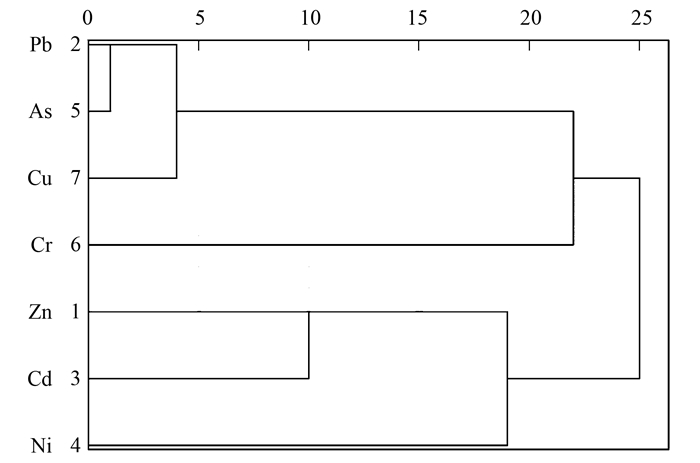
|
图 2 食源植物重金属聚类分析 Fig. 2 Cluster analysis of heavy metals in food plants |
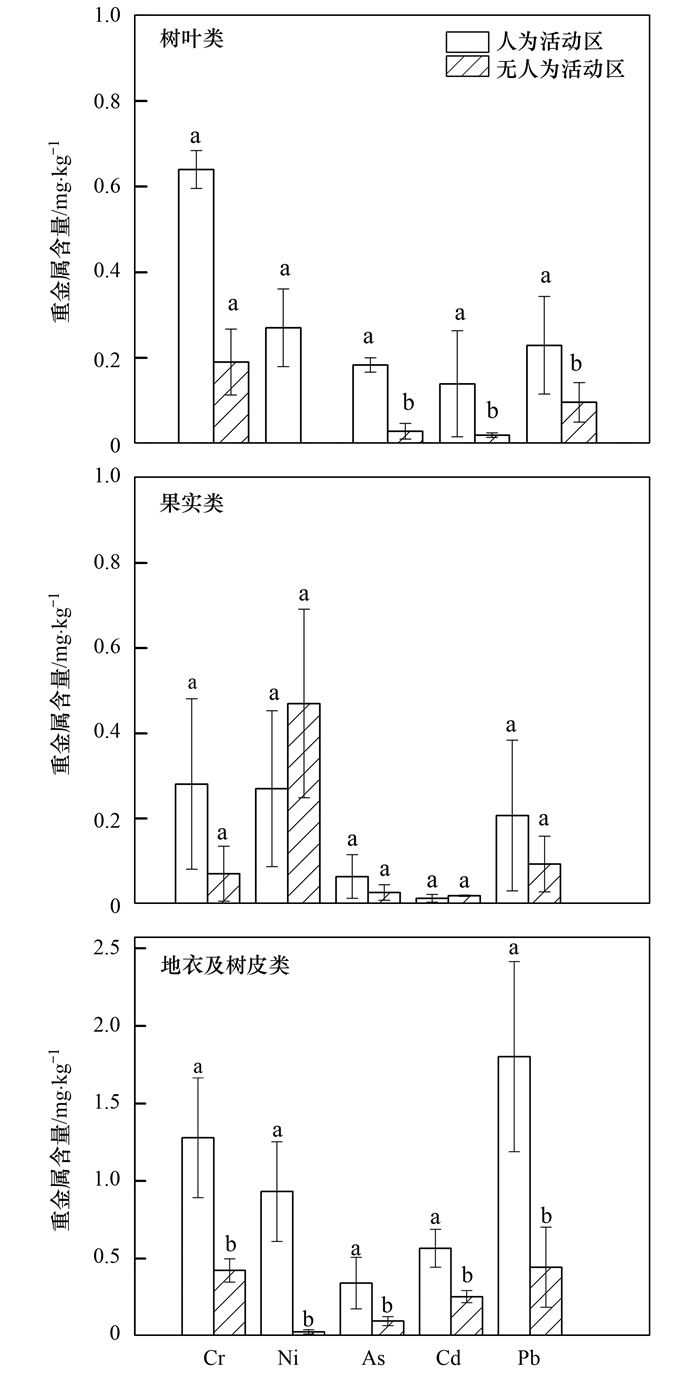
|
同一重金属内不同小写字母表示有、无人为活动在0.05水平存在显著性差异,下同 图 3 人类活动对食源植物重金属含量影响 Fig. 3 Effects of human activities on heavy metal contents in food plants |
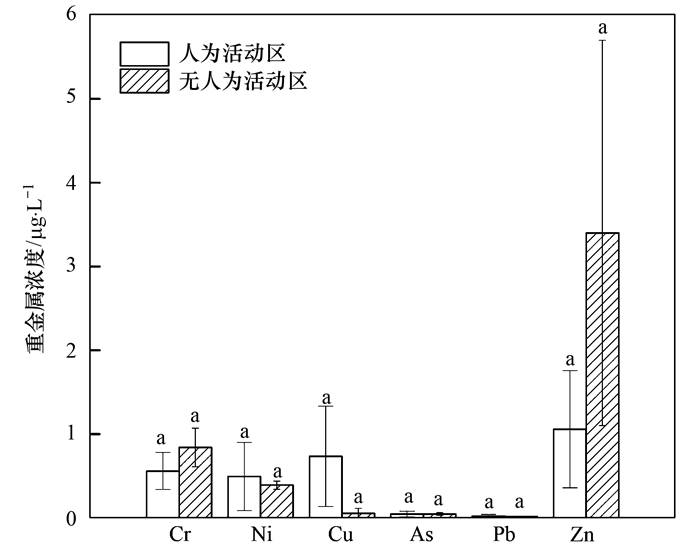
|
图 4 人类活动对水体重金属浓度影响 Fig. 4 Effects of human activities on heavy metal concentrations in water |
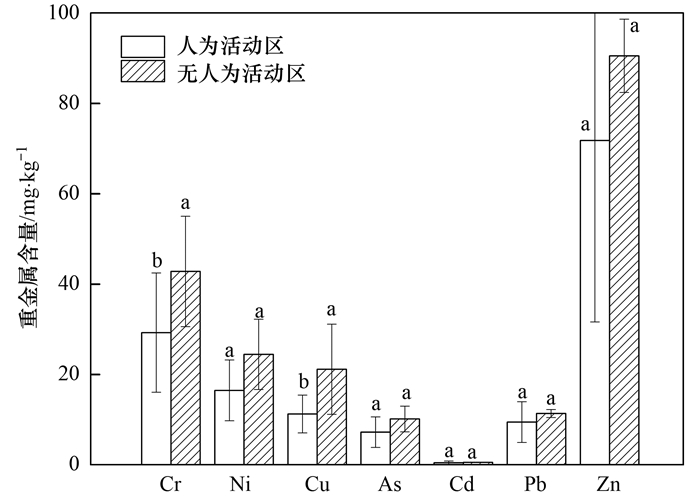
|
图 5 人类活动对土壤重金属含量影响 Fig. 5 Effects of human activities on heavy metal contents in soil |
|
|
表 11 植物、土壤和水重金属含量相关性1) Table 11 Correlation table of heavy metal contents among plants, soil, and water |
3 讨论 3.1 川金丝猴食源植物重金属污染特征分析
神农架川金丝猴食源植物中不同种类植物重金属含量差异大, 树皮和地衣重金属含量要高于果实类和树叶类, 这是由于不同植物生物学特性不一致, 对重金属的吸收和富集能力不同导致[35].食源植物中Ni超标率是最高的为35%, Ni具有生殖危害毒性, 食源植物Ni元素积累可能会对川金丝猴的生殖系统造成损伤[36], 应加强对川金丝猴栖息地Ni重金属的防控措施, 避免损害川金丝猴健康.食源植物中披针叶胡颓子、荚蒾叶、广布野豌豆、树皮和地衣均受到不同程度的污染, 在今后对川金丝猴重金属保护工作中可以着重关注其受污染情况, 以反映食源植物整体受重金属污染水平.地衣及树皮类重金属污染程度大于树叶类、果实类, 这可能是因为地衣和树皮比树叶、果实暴露在外界环境中时间要长有关, 地衣和树皮几乎是全年都暴露在重金属环境下, 而树叶与果实在春秋季处于暴露状态, 还可能与重金属元素随着植物从根部迁移和转化到树叶和果实等部位的过程中受到细胞壁及细胞膜阻碍作用有关[37].
3.2 川金丝猴食源植物重金属健康风险评价川金丝猴与人类有很多生理上的相似之处, 运用人类健康风险THQ模型对其进行健康风险评价具有合理性.结果表明, THQ值在树皮及地衣类最高, 对川金丝猴健康存在一定程度威胁, 应加强对川金丝猴“秋冬季补食”措施, 来降低川金丝猴对地衣及树皮类的取食量.川金丝猴全年大部分时期都是以叶子为食, 在秋冬季叶子可利用率最低时, 才会增加树皮或地衣的取食量[38], 所以川金丝猴实际取食地衣及树皮的健康风险比理论值要小, 川金丝猴食源植物中As元素THQ值在各采样点和各类食源植物中都是最大值, As会诱导DNA损伤并抑制基因表达[39], 川金丝猴长期食用受As污染的植物存在健康风险, 应重点加强栖息地As污染防控.
3.3 栖息地重金属生态风险评价神农架川金丝猴栖息地水体重金属总体处于无污染水平, 这可能是由于水体中重金属浓度本身就比较低, 且水体中重金属除了以溶解态存在以外, 还以悬浮态、颗粒态等形态赋存于水体沉积物中[40]. 有研究表明即使水体中重金属浓度较低, 但通过饮水、食物链等途径长期地进入动物体, 可能会对动物体健康产生威胁[41], 应对神农架川金丝猴栖息地水体定期开展重金属风险评估和防治工作, 以免对川金丝猴健康产生威胁.JHL和HXC两个地区土壤Cd处于轻度污染状态, 由表 1可知, JHL和HXC是游客聚集区, 会产生垃圾、汽车尾气等污染, 推测土壤Cd污染有可能是来自游客活动干扰和排放大量汽车尾气等途径产生, 同时, 也不能排除跟湖北省土壤Cd含量较高有关[42]. Cd中毒会造成野生动物心肌、骨骼肌变性等现象[43], 有研究显示川金丝猴以食土作为矿物质元素补充[44], 因此土壤Cd处于污染状态, 可能会对神农架川金丝猴健康存在潜在威胁.土壤和水体中其余元素均无明显超标, 各样品中较高的重金属值可能是污染趋势和风险指示, 应重点控制重金属污染, 保护川金丝猴栖息地环境.
3.4 人类活动对栖息地重金属影响(1) 食源植物重金属来源初步分析 聚类分析将食源植物重金属分为4类, 第1类为As、Cu和Pb, 这与有、无人为活动区中树叶类和地衣及树皮类中As和Pb都具有显著差异性分析结果一致(见图 3), 而由表 1可知, 栖息地内有居民活动、游客聚集等活动, 可以推测食源植物中As和Pb可能主要受人类活动的干扰, 可能与栖息地内车流量大有关[45], 可以在栖息地内各主要公路旁移栽银杏、桂花等对重金属具有较强富集作用的植物[46, 47].第2类为Cr, 熊秋林等[48]的研究发现大气沉降对Cr累积有影响, 而植物还可以通过叶片吸收空气中重金属元素[49], 推测大气沉降可能是食源植物Cr来源之一.第3类为Zn和Cd, 而植物与土壤中的Zn和Cd含量具有显著相关性, 可以推测食源植物中Zn和Cd可能主要来源于土壤. 第4类Ni, 聚类分析距离比其他重金属远, 表明Ni有其他的来源, 如自然源[50].
(2) 在有、无人为活动区中土壤中Cr和Cu具有显著差异性.土壤Cr和Cu可能来自于人类活动干扰和交通污染, 土壤中除Cd元素外, 其余元素重金属含量均低于湖北省土壤重金属背景值, 因此土壤中Cu、Zn、Pb、Cr、Ni和As元素可能主要来源于成土母质[51].川金丝猴栖息地人类活动频繁, 可能也会对栖息地水源产生不利影响, 如农业面源污染、工业废水、生活污水的排放都会造成水体污染.整体来看, 人类活动对神农架川金丝猴栖息地重金属富集具有不可忽视的作用, 这与Zhao等[52]对人类活动导致大熊猫栖息地土壤、水体和竹子中存在重金属污染风险的研究结果一致, 在今后开展川金丝猴保护工作中, 应减少人类活动对栖息地产生的污染.
4 结论(1) 神农架川金丝猴栖息地不同食源植物重金属含量差异大, 其中As对川金丝猴造成健康风险, 食用地衣和树皮存在的健康风险大于树叶和果实, 应加强对川金丝猴“秋冬季补食”措施, 来代替川金丝猴对地衣和树皮的取食.
(2) 神农架川金丝猴栖息地水体处于无污染状态, 土壤重金属Cd存在中度污染, 在开展川金丝猴工作中, 应结合栖息地重金属污染情况和觅食习性, 全面综合考虑重金属对川金丝猴产生的危害.
(3) 重金属污染主要来源之一是人类活动, 人类活动干扰会增强神农架川金丝猴栖息地食源植物、土壤重金属污染, 应合理限制人类活动对川金丝猴栖息地的干扰, 对其旅游人数实行合理限量.
(4) 由于野外采集金丝猴毛发、新鲜粪便等样品难度较大, 本研究只采集到栖息地土壤、水体、食源植物等样品进行研究, 不能直接反映其体内重金属含量, 在今后的研究中, 可以研究川金丝猴体内重金属污染情况, 进一步探究重金属污染对川金丝猴生理健康的影响.
| [1] | Wei B G, Yang L S. A review of heavy metal contaminations in urban soils, urban road dusts and agricultural soils from China[J]. Microchemical Journal, 2010, 94(2): 99-107. DOI:10.1016/j.microc.2009.09.014 |
| [2] | Chen H Y, Teng Y G, Lu S J, et al. Contamination features and health risk of soil heavy metals in China[J]. Science of the Total Environment, 2015, 512-513: 143-153. DOI:10.1016/j.scitotenv.2015.01.025 |
| [3] | Li X Z, Wang M E, Jiang R, et al. Evaluation of joint toxicity of heavy metals and herbicide mixtures in soils to earthworms (Eisenia fetida)[J]. Journal of Environmental Sciences, 2020, 94: 137-146. DOI:10.1016/j.jes.2020.03.055 |
| [4] | Dutta S, Mitra M, Agarwal P, et al. Oxidative and genotoxic damages in plants in response to heavy metal stress and maintenance of genome stability[J]. Plant Signaling & Behavior, 2018, 13(8). DOI:10.1080/15592324.2018.1460048 |
| [5] | Liu Q, Chen Y P, Maltby L, et al. Exposure of the endangered golden monkey (Rhinopithecus roxellana) to heavy metals: a comparison of wild and captive animals[J]. Environmental Science and Pollution Research, 2015, 22(9): 6713-6720. DOI:10.1007/s11356-014-3877-5 |
| [6] | Berglund Å M M, Koivula M J, Eeva T. Species- and age-related variation in metal exposure and accumulation of two passerine bird species[J]. Environmental Pollution, 2011, 159(10): 2368-2374. DOI:10.1016/j.envpol.2011.07.001 |
| [7] | Xiong B, Xu T, Li R P, et al. Heavy metal accumulation and health risk assessment of crayfish collected from cultivated and uncultivated ponds in the Middle Reach of Yangtze River[J]. Science of the Total Environment, 2020, 739. DOI:10.1016/j.scitotenv.2020.139963 |
| [8] |
蔡庆华, 罗情怡, 谭路, 等. 神农架国家公园: 现状与展望[J]. 长江流域资源与环境, 2021, 30(6): 1378-1383. Cai Q H, Luo Q Y, Tan L, et al. Shennongjia National Park: present situation and prospect[J]. Resources and Environment in the Yangtze Basin, 2021, 30(6): 1378-1383. |
| [9] |
铁军, 张晶, 彭林鹏, 等. 神农架川金丝猴栖息地优势树种生态位及食源植物[J]. 植物生态学报, 2009, 33(3): 482-491. Tie J, Zhang J, Peng L P, et al. Dominant trees' niche characteristics and food plants in Rhinopithecus roxellana habitat in Shennongjia, China[J]. Chinese Journal of Plant Ecology, 2009, 33(3): 482-491. DOI:10.3773/j.issn.1005-264x.2009.03.007 |
| [10] |
李义明, 廖明尧, 喻杰, 等. 社群大小的年变化、气候和人类活动对神农架自然保护区川金丝猴日移动距离的影响[J]. 生物多样性, 2005, 13(5): 432-438. Li Y M, Liao M Y, Yu J, et al. Effects of annual change in group size, human disturbances and weather on daily travel distance of a group in Sichuan snub-nosed monkey (Rhi-nopithecus roxellana) in Shennongjia Nature Reserve, China[J]. Biodiversity Science, 2005, 13(5): 432-438. DOI:10.3321/j.issn:1005-0094.2005.05.008 |
| [11] |
白洢露, 李艳红, 郑维超, 等. 唐家河国家级自然保护区川金丝猴生境适宜性评价[J]. 生态学报, 2021, 41(11): 4460-4468. Bai Y L, Li Y H, Zheng W C, et al. Habitat suitability assessment of Rhinopithecus roxellana in Tangjiahe National Nature Reserve[J]. Acta Ecologica Sinica, 2021, 41(11): 4460-4468. |
| [12] |
周婷, 陈万旭, 李江风, 等. 神农架林区人类活动与生境质量的空间关系[J]. 生态学报, 2021, 41(15): 6134-6145. Zhou T, Chen W X, Li J F, et al. Spatial relationship between human activities and habitat quality in Shennongjia Forest Region from 1995 to 2015[J]. Acta Ecologica Sinica, 2021, 41(15): 6134-6145. |
| [13] | 杜永林, 杨敬元, 任立志. 国宝金丝猴在神农架的发现与科研[J]. 档案记忆, 2021(5): 20-22. DOI:10.3969/j.issn.1003-8167.2021.05.006 |
| [14] | 刘汉泽, 喻玲. 神农架冰雪游升温[N]. 湖北日报, 2020-12-15(11). |
| [15] |
于晓东, 周红章, 罗天宏. 神农架保护区大步甲和蜗步甲属生境选择与物种多样性研究[J]. 生物多样性, 2001, 9(3): 214-221. Yu X D, Zhou H Z, Luo T H. Habitat distribution and species diversity of Carabus and Cychrus in Shennongjia Nature Reserve, Hubei Province[J]. Biodiversity Science, 2001, 9(3): 214-221. DOI:10.3321/j.issn:1005-0094.2001.03.003 |
| [16] |
彭乾乾, 李亭亭, 汪正祥, 等. 神农架国家公园生态旅游环境容量研究[J]. 湖北大学学报(自然科学版), 2017, 39(5): 451-454. Peng Q Q, Li T T, Wang Z X, et al. The ecotourism environment capacity of Shennongjia National Park[J]. Journal of Hubei University (Natural Science), 2017, 39(5): 451-454. DOI:10.3969/j.issn.1000-2375.2017.05.003 |
| [17] |
杨敬元, 刘学聪, 廖明尧. 神农架一个川金丝猴群的食物分布[J]. 动物学杂志, 2014, 49(4): 465-475. Yang J Y, Liu X C, Liao M X. Food distribution for a group of Rhinopithecus roxellana in Shennongjia, China[J]. Chinese Journal of Zoology, 2014, 49(4): 465-475. |
| [18] |
铁军, 张晶, 彭林鹏, 等. 神农架川金丝猴冬春季节取食影响因素[J]. 生态学杂志, 2011, 30(11): 2562-2569. Tie J, Zhang J, Peng L P, et al. Factors affecting the foraging of Rhinopithecus roxellana in Shennongjia Nature Reserve in winter and spring[J]. Chinese Journal of Ecology, 2011, 30(11): 2562-2569. |
| [19] |
朱源, 胡灿实, 张明明, 等. 贵州草海湿地水鸟重金属暴露风险综合评估与保护管理应用[J]. 中国环境科学, 2021, 41(10): 4770-4781. Zhu Y, Hu C S, Zhang M M, et al. Comprehensive assessment on heavy metal exposure risk to waterbirds and implications for conservation and management in Caohai wetland, China[J]. China Environmental Science, 2021, 41(10): 4770-4781. DOI:10.3969/j.issn.1000-6923.2021.10.034 |
| [20] |
张清华, 韦永著, 曹建华, 等. 柳江流域饮用水源地重金属污染与健康风险评价[J]. 环境科学, 2018, 39(4): 1598-1607. Zhang Q H, Wei Y Z, Cao J H, et al. Heavy metal pollution of the drinking water sources in the Liujiang River Basin, and related health risk assessment[J]. Environmental Science, 2018, 39(4): 1598-1607. |
| [21] | Zhao Y, Chen Y P, Ellison A M, et al. Establish an environmentally sustainable Giant Panda National Park in the Qinling Mountains[J]. Science of the Total Environment, 2019, 668: 979-987. DOI:10.1016/j.scitotenv.2019.03.070 |
| [22] | Adamu C I, Nganje T N, Edet A. Heavy metal contamination and health risk assessment associated with abandoned barite mines in Cross River State, southeastern Nigeria[J]. Environmental Nanotechnology, Monitoring & Management, 2015, 3: 10-21. |
| [23] |
杨剑洲, 王振亮, 高健翁, 等. 海南省集约化种植园中谷物、蔬菜和水果中重金属累积程度及健康风险[J]. 环境科学, 2021, 42(10): 4916-4924. Yang J Z, Wang Z L, Gao J W, et al. Accumulation and health risk of heavy metals in cereals, vegetables, and fruits of intensive plantations in Hainan province[J]. Environmental Science, 2021, 42(10): 4916-4924. DOI:10.3969/j.issn.1000-6923.2021.10.051 |
| [24] | GB 2762-2017《食品安全国家标准食品中污染物限量》[J]. 中国食品卫生杂志, 2018, 30(3): 329-340. |
| [25] |
陈志良, 黄玲, 周存宇, 等. 广州市蔬菜中重金属污染特征研究与评价[J]. 环境科学, 2017, 38(1): 389-398. Chen Z L, Huang L, Zhou C Y, et al. Characteristics and evaluation of heavy metal pollution in vegetables in Guangzhou[J]. Environmental Science, 2017, 38(1): 389-398. |
| [26] |
任婉侠, 薛冰, 马志孝, 等. 老工业搬迁区土壤重金属污染特征及潜在生态风险—以沈阳铁西老工业区为例[J]. 可持续发展, 2012, 2(4): 159-166. Ren W X, Xue B, Ma Z X, et al. Characters and potential ecological risks of heavy metals in soil of Chinese Brownfield Redevelopment Site*——Case of Tiexi Old Industrial Area, Shenyang City[J]. Sustainable Development, 2012, 2(4): 159-166. |
| [27] |
马迎群, 时瑶, 秦延文, 等. 浑河上游(清原段)水环境中重金属时空分布及污染评价[J]. 环境科学, 2014, 35(1): 108-116. Ma Y Q, Shi Y, Qin Y W, et al. Temporal-spatial distribution and pollution assessment of heavy metals in the upper reaches of Hunhe River (Qingyuan Section), Northeast China[J]. Environmental Science, 2014, 35(1): 108-116. DOI:10.3969/j.issn.1007-0370.2014.01.035 |
| [28] |
任建丽, 金海龙, 叶茂, 等. 艾比湖湿地自然保护区水质分析与评价[J]. 干旱区资源与环境, 2011, 25(5): 154-157. Ren J L, Jin H L, Ye M, et al. Analysis and evaluation of water quality of Aibihu Lake Wetland Natural Reserve[J]. Journal of Arid Land Resources and Environment, 2011, 25(5): 154-157. |
| [29] | Huang Y P, Xiang J T, Wang C H, et al. Lichen as a Biomonitor for vehicular emission of metals: a risk assessment of lichen consumption by the Sichuan snub-nosed monkey (Rhinopithecus roxellana)[J]. Ecotoxicology and Environmental Safety, 2019, 180: 679-685. DOI:10.1016/j.ecoenv.2019.05.047 |
| [30] | USEPA. Regional Screening Levels (RSL)[EB/OL]. USEPA. https: //www.epa.gov/risk/regional-screening-levels-rsls, 2019-09-10. |
| [31] |
梁冰, 戚汉君, 张树义, 等. 笼养川金丝猴不同年龄阶段的发育特征[J]. 动物学报, 2001, 47(4): 381-387. Liang B, Qi H J, Zhang S Y, et al. Developmental traits of captive Sichuan Snub-nosed monkeys (Rhinopithecus roxellana) at different age stages[J]. Acta Zoologica Sinica, 2001, 47(4): 381-387. |
| [32] |
王长美, 孙伟东, 葛超. 川金丝猴在南京地区人工饲养与管理研究[J]. 畜牧与兽医, 2020, 52(3): 135-138. Wang C M, Sun W D, Ge C. Study on the artificial breeding and management of Golden snub-nosed monkey in Nanjing[J]. Animal Husbandry & Veterinary Medicine, 2020, 52(3): 135-138. |
| [33] | Li Y M. Seasonal variation of diet and food availability in a group of Sichuan snub-nosed monkeys in Shennongjia Nature Reserve, China[J]. American Journal of Primatology, 2006, 68(3): 217-233. DOI:10.1002/ajp.20220 |
| [34] |
罗鹏, 雷青海, 王辉太, 等. 兰州市动物园川金丝猴的饲养管理及种群现状[J]. 野生动物学报, 2020, 41(4): 879-884. Luo P, Lei Q H, Wang H T, et al. The husbandry and population status of Rhinopithecus roxellana in the Lanzhou Zoo[J]. Chinese Journal of wildlife, 2020, 41(4): 879-884. DOI:10.3969/j.issn.1000-0127.2020.04.005 |
| [35] | Vymazal J, B Drˇ ezinová T. Heavy metals in plants in constructed and natural wetlands: concentration, accumulation and seasonality[J]. Water Science & Technology, 2015, 71(2): 268-276. |
| [36] | Doreswamy K, Shrilatha B, Rajeshkumar T, et al. Nickel-induced oxidative stress in testis of mice: evidence of DNA damage and genotoxic effects[J]. Journal of Andrology, 2004, 25(6): 996-1003. DOI:10.1002/j.1939-4640.2004.tb03173.x |
| [37] |
费毅琴, 肖凌, 汪波, 等. 37种植物类药材中重金属和有害元素残留分析及风险评估[J]. 药物分析杂志, 2021, 41(6): 1000-1008. Fei Y Q, Xiao L, Wang B, et al. Residue analysis and risk assessment of heavy metals and harmful elements in 37 plant medicinal materials[J]. Chinese Journal of Pharmaceutical Analysis, 2021, 41(6): 1000-1008. |
| [38] | Hou R, Chapman C A, Jay O, et al. Cold and hungry: combined effects of low temperature and resource scarcity on an edge-of-range temperate primate, the golden snub-nose monkey[J]. Ecography, 2020, 43(11): 1672-1682. DOI:10.1111/ecog.05295 |
| [39] | Zhang A L, Chen L, Ma L, et al. Role of H3K18ac-regulated nucleotide excision repair-related genes in arsenic-induced DNA damage and repair of HaCaT cells[J]. Human & Experimental Toxicology, 2020, 39(9): 1168-1177. |
| [40] |
周巧巧, 任勃, 李有志, 等. 中国河湖水体重金属污染趋势及来源解析[J]. 环境化学, 2020, 39(8): 2044-2054. Zhou Q Q, Ren B, Li Y Z, et al. Trends and sources of dissolved heavy metal pollution in water of rivers and lakes in China[J]. Environmental Chemistry, 2020, 39(8): 2044-2054. |
| [41] | Sundaray S K, Nayak B B, Lin S, et al. Geochemical speciation and risk assessment of heavy metals in the river estuarine sediments—A case study: Mahanadi basin, India[J]. Journal of Hazardous Materials, 2011, 186(2-3): 1837-1846. DOI:10.1016/j.jhazmat.2010.12.081 |
| [42] |
徐启胜, 李雨晴, 陈燕, 等. 我国中南地区土壤重金属污染状况及其空间分布研究[J]. 北方农业学报, 2018, 46(3): 93-100. Xu Q S, Li Y Q, Chen Y, et al. Study on heavy metal pollution and its spatial distribution in soil in central South China[J]. Journal of Northern Agriculture, 2018, 46(3): 93-100. DOI:10.3969/j.issn.2096-1197.2018.03.18 |
| [43] |
王祥生, 娄虎, 张明海. 野生动物重金属污染研究进展[J]. 生命科学研究, 2019, 23(1): 78-86. Wang X S, Lou H, Zhang M H. Advances in heavy metal pollution in wildlife[J]. Life Science Research, 2019, 23(1): 78-86. |
| [44] |
何凤芝, 李延鹏, 高颖, 等. 土壤pH值对秦岭川金丝猴食土行为的影响[J]. 兽类学报, 2018, 38(1): 12-17. He F Z, Li Y P, Gao Y, et al. Effect of soil pH on geophagy in golden snub-nosed monkey (Rhinopithecus roxellana) in Qinling Mountains[J]. Acta Theriologica Sinica, 2018, 38(1): 12-17. |
| [45] | Ewen C, Anagnostopoulou M A, Ward N I. Monitoring of heavy metal levels in roadside dusts of Thessaloniki, Greece in relation to motor vehicle traffic density and flow[J]. Environmental Monitoring and Assessment, 2009, 157(1): 483-498. |
| [46] |
唐敏, 张欣, 刘燕, 等. 镉在3种乔木中的积累及其亚细胞分布和化学形态研究[J]. 环境科学学报, 2021, 41(6): 2440-2447. Tang M, Zhang X, Liu Y, et al. Accumulation, subcellular distribution and chemical forms of cadmium in three tree species[J]. Acta Scientiae Circumstantiae, 2021, 41(6): 2440-2447. |
| [47] |
张前进, 刘华, 陈永生, 等. 合肥老城区土壤重金属分布格局及树木富集重金属潜力[J]. 生态学杂志, 2020, 39(12): 4140-4147. Zhang Q J, Liu H, Chen Y S, et al. Distribution pattern of heavy metals in soil and the potential of heavy metals enrichment by trees in the old town of Hefei City[J]. Chinese Journal of Ecology, 2020, 39(12): 4140-4147. |
| [48] |
熊秋林, 肖红伟, 程朋根, 等. 北京表层土壤重金属污染分布及大气沉降贡献[J]. 生态环境学报, 2021, 30(4): 816-824. Xiong Q L, Xiao H W, Cheng P G, et al. Pollution distribution of topsoil heavy metals in Beijing and its atmospheric deposition contribution[J]. Ecology and Environment Sciences, 2021, 30(4): 816-824. |
| [49] |
刘玲, 方炎明, 王顺昌, 等. 7种树木的叶片微形态与空气悬浮颗粒吸附及重金属累积特征[J]. 环境科学, 2013, 34(6): 2361-2367. Liu L, Fang Y M, Wang S C, et al. Leaf micro-morphology and features in adsorbing air suspended particulate matter and accumulating heavy metals in seven tress species[J]. Environmental Science, 2013, 34(6): 2361-2367. |
| [50] |
张杰, 郭西亚, 曾野, 等. 太湖流域河流沉积物重金属分布及污染评估[J]. 环境科学, 2019, 40(5): 2202-2210. Zhang J, Guo X Y, Zeng Y, et al. Spatial distribution and pollution assessment of heavy metals in river sediments from Lake Taihu Basin[J]. Environmental Science, 2019, 40(5): 2202-2210. DOI:10.3969/j.issn.1000-6923.2019.05.049 |
| [51] |
于旦洋, 王颜红, 丁茯, 等. 近十年来我国土壤重金属污染源解析方法比较[J]. 土壤通报, 2021, 52(4): 1000-1008. Yu D Y, Wang Y H, Ding F, et al. Comparison of analysis methods of soil heavy metal pollution sources in China in last ten years[J]. Chinese Journal of Soil Science, 2021, 52(4): 1000-1008. |
| [52] | Zhao Y, Chen Y P, Zheng Y J, et al. Quantifying the heavy metal risks from anthropogenic contributions in Sichuan panda (Ailuropoda melanoleuca melanoleuca) habitat[J]. Science of the Total Environment, 2020, 745. DOI:10.1016/j.scitotenv.2020.140941 |
 2022, Vol. 43
2022, Vol. 43


